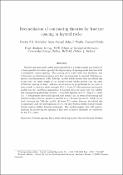Options
Reconciliation of contrasting theories for fracture spacing in layered rocks
Date Issued
2011-04
Date Available
2011-07-19T16:19:17Z
Abstract
Natural and man-made brittle layers embedded in a weaker matrix and subjected to layer-parallel extension typically develop an array of opening-mode fractures with a remarkably regular spacing. This
spacing often scales with layer thickness, and it decreases as extension increases until fracture saturation is reached. Existing analytical one-dimensional (1-D) 'full-slip' models, which assume that interfacial slip occurs over the entire length of the fracture-bound blocks, predict that the ratio of fracture spacing to layer thickness at saturation is proportional to the ratio of layer tensile to interface shear strength (T/s). Using 2-D discontinuum mechanical models run for conditions appropriate to layered rocks, we show that fracture spacing at saturation decreases linearly with decreasing T/s ratio, as predicted by 1-D models. At low T/s ratios (ca. <3.0), however, interfacial slip is suppressed and the heterogeneous 2-D
stress distribution within fracture-bound blocks controls further fracture nucleation, as predicted by an existing 2-D 'fracture infill criterion'. The applicability of the two theories is hence T/s ratio dependent.
Our models illustrate that fracture spacing in systems permitting interfacial slip is not necessarily an indicator of fracture system maturity. Fracture spacing is expected to decrease with increasing overburden pressure and decreasing layer tensile strength.
spacing often scales with layer thickness, and it decreases as extension increases until fracture saturation is reached. Existing analytical one-dimensional (1-D) 'full-slip' models, which assume that interfacial slip occurs over the entire length of the fracture-bound blocks, predict that the ratio of fracture spacing to layer thickness at saturation is proportional to the ratio of layer tensile to interface shear strength (T/s). Using 2-D discontinuum mechanical models run for conditions appropriate to layered rocks, we show that fracture spacing at saturation decreases linearly with decreasing T/s ratio, as predicted by 1-D models. At low T/s ratios (ca. <3.0), however, interfacial slip is suppressed and the heterogeneous 2-D
stress distribution within fracture-bound blocks controls further fracture nucleation, as predicted by an existing 2-D 'fracture infill criterion'. The applicability of the two theories is hence T/s ratio dependent.
Our models illustrate that fracture spacing in systems permitting interfacial slip is not necessarily an indicator of fracture system maturity. Fracture spacing is expected to decrease with increasing overburden pressure and decreasing layer tensile strength.
External Notes
Associated movies require QuickTime to view
Sponsorship
Science Foundation Ireland
Type of Material
Journal Article
Publisher
Elsevier
Journal
Journal of Structural Geology
Volume
33
Issue
4
Start Page
551
End Page
565
Copyright (Published Version)
2011 Elsevier Ltd.
Subject – LCSH
Fracture mechanics
Rock mechanics
Joints (Geology)
Shear (Mechanics)
Web versions
Language
English
Status of Item
Peer reviewed
ISSN
0191-8141
This item is made available under a Creative Commons License
File(s)
Loading...
Name
Schopfer_et_al_JSG_2011_repository.pdf
Description
Paper
Size
1.68 MB
Format
Adobe PDF
Checksum (MD5)
48f069749f1dfa530c9fef84eac97cc0
No Thumbnail Available
Name
JointsMovies.zip
Description
Associated movies
Size
12.54 MB
Format
Unknown
Checksum (MD5)
11cfba3b07e0aea572bcfacf34b13721
Owning collection